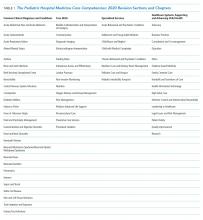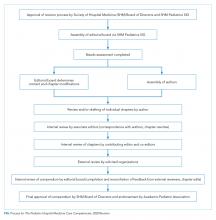The Pediatric Hospital Medicine Core Competencies: 2020 Revision. Introduction and Methodology (C)
BACKGROUND: The Pediatric Hospital Medicine (PHM) Core Competencies define the expertise required of practitioners and provide a framework for educational activities. Since initial publication in 2010, the scope of practice for pediatric hospitalists has evolved in clinical, research, administrative, and educational arenas.
OBJECTIVE: To describe the methodology utilized in the revision of The PHM Core Competencies to ensure a product reflective of current roles and expectations for pediatric hospitalists across all training pathways and practice settings.
METHODS: The Society of Hospital Medicine (SHM) Pediatrics Special Interest Group supported the initiation of the revision. A diverse group of editors and authors was engaged from among members of SHM, the American Academy of Pediatrics and the Academic Pediatrics Association. Editorial roles were expanded to represent all practice settings. More than 80 individuals contributed, representing both university and community sites, and all US geographic regions. Editors conducted a two-part needs assessment; a survey related to content was distributed to the PHM community and content from recent conferences and PHM related publications was reviewed. The final compendium consists of 4 sections and 66 chapters, including 12 new chapters and 36 chapters with substantial changes. Individual chapters and the entire compendium underwent rigorous internal and external review.
CONCLUSION: The PHM Core Competencies: 2020 Revision reflects the work of a broad spectrum of PHM practitioners responding to the practice and educational changes in PHM over the past decade. The compendium can inform education, training, and career development for pediatric hospitalists practicing now and in coming years.
© 2020 Society of Hospital Medicine
The compendium includes 66 chapters on both clinical and nonclinical topics, divided into four sections—Common Clinical Diagnoses and Conditions, Core Skills, Specialized Services, and Healthcare Systems: Supporting and Advancing Child Health (Table 1). Within each chapter is an introductory paragraph and learning objectives in three domains of educational outcomes—cognitive (knowledge), psychomotor (skills), and affective (attitudes)—as well as systems organization and improvement, to reflect the emphasis of PHM practice on improving healthcare systems. The objectives encompass a range of observable behaviors and other attributes, from foundational skills such as taking a history and performing a physical exam to more advanced actions such as participating in the development of care models to support the health of complex patient populations. Implicit in these objectives is the expectation that pediatric hospitalists build on experiences in medical school and residency training to attain a level of competency at the advanced levels of a developmental continuum, such as proficient, expert, or master.14
The objectives also balance specificity to the topic with a timeless quality, allowing for flexibility both as new information emerges and when applied to various educational activities and learner groups. Each chapter can stand alone, and thus themes recur if one reads the compendium in its entirety. However, in order to reflect related content among the chapters, the appendix contains a list of associated chapters (Chapter Links) for further exploration. In addition, a short reference list is provided in each chapter to reflect the literature and best practices at the time of publication.
Finally, The PHM Core Competencies: 2020 Revision reflect the status of children as a vulnerable population. Care for hospitalized children requires attention to many elements unique to the pediatric population. These include age-based differences in development, behavior, physiology, and prevalence of clinical conditions, the impact of acute and chronic disease states on child development, the use of medications and other medical interventions with limited investigative guidance, and the role of caregivers in decision-making and care delivery. Heightened awareness of these factors is required in the hospital setting, where diagnoses and interventions often include the use of high-risk modalities and require coordination of care across multiple providers.
METHODS
Project Initiation
Revision of The PHM Core Competencies: 2020 Revision began in early 2017 following SHM’s work on The Core Competencies in Hospital Medicine 2017 Revision.15 The Executive Committee of the SHM Pediatrics Special Interest Group (SIG) supported the initiation of the revision. The 3 editors from the original compendium created an initial plan for the project that included a proposed timeline, processes for engagement of previously involved experts and new talent, and performance of a needs assessment to guide content selection. The Figure highlights these and other important steps in the revision process.
Editor and Associate Editor Selection
The above editors reviewed best practice examples of roles and responsibilities for editor and associate editor positions from relevant, leading societies and journals. From this review, the editors created an editorial structure specifically for The PHM Core Competencies: 2020 Revision. A new position of Contributing Editor was created to address the need for dedicated attention to the community site perspective and ensure review of all content, within and across chapters, by a pediatric hospitalist who is dedicated to this environment. Solicitation for additional editors and associate editors occurred via the SHM Pediatrics SIG to the wider SHM membership. The criteria for selection included active engagement in regional or national activities related to the growth and operations of PHM, strong organizational and leadership skills, including the ability to manage tasks and foster creativity, among others. In addition, a deliberate effort was made to recruit a diverse editorial cohort, considering geographic location, primary work environment, organizational affiliations, content expertise, time in practice, gender, and other factors.






